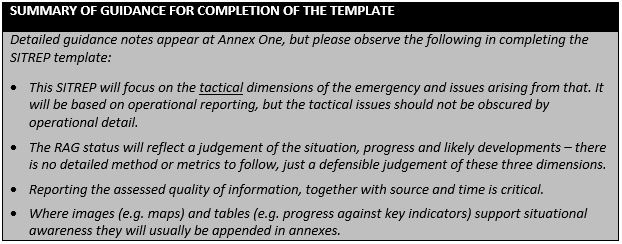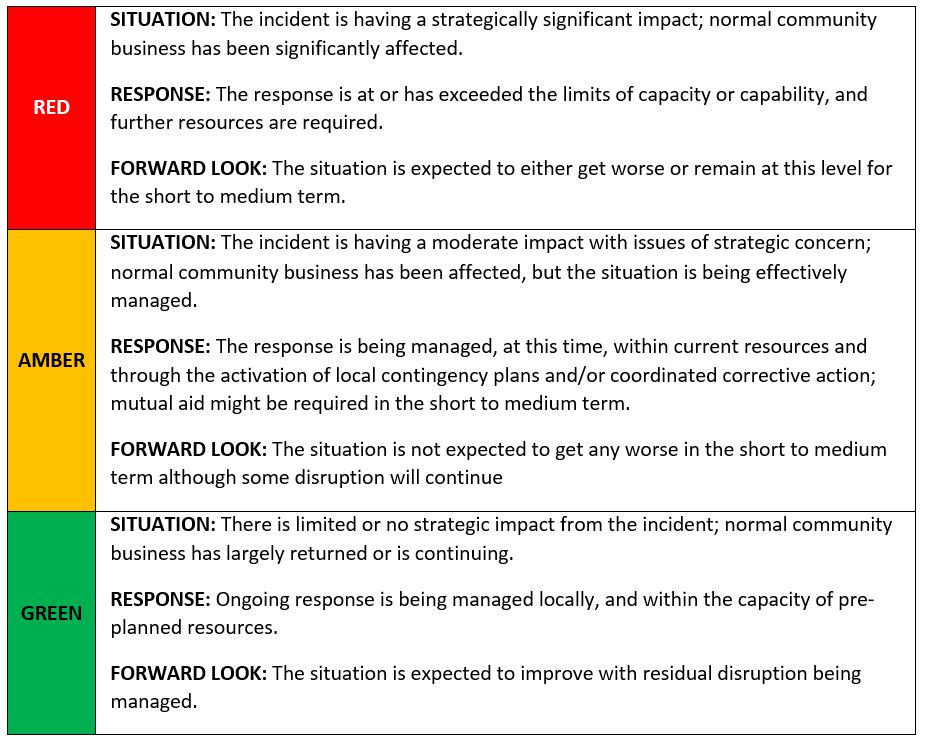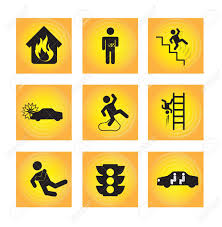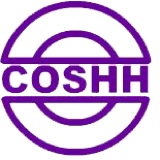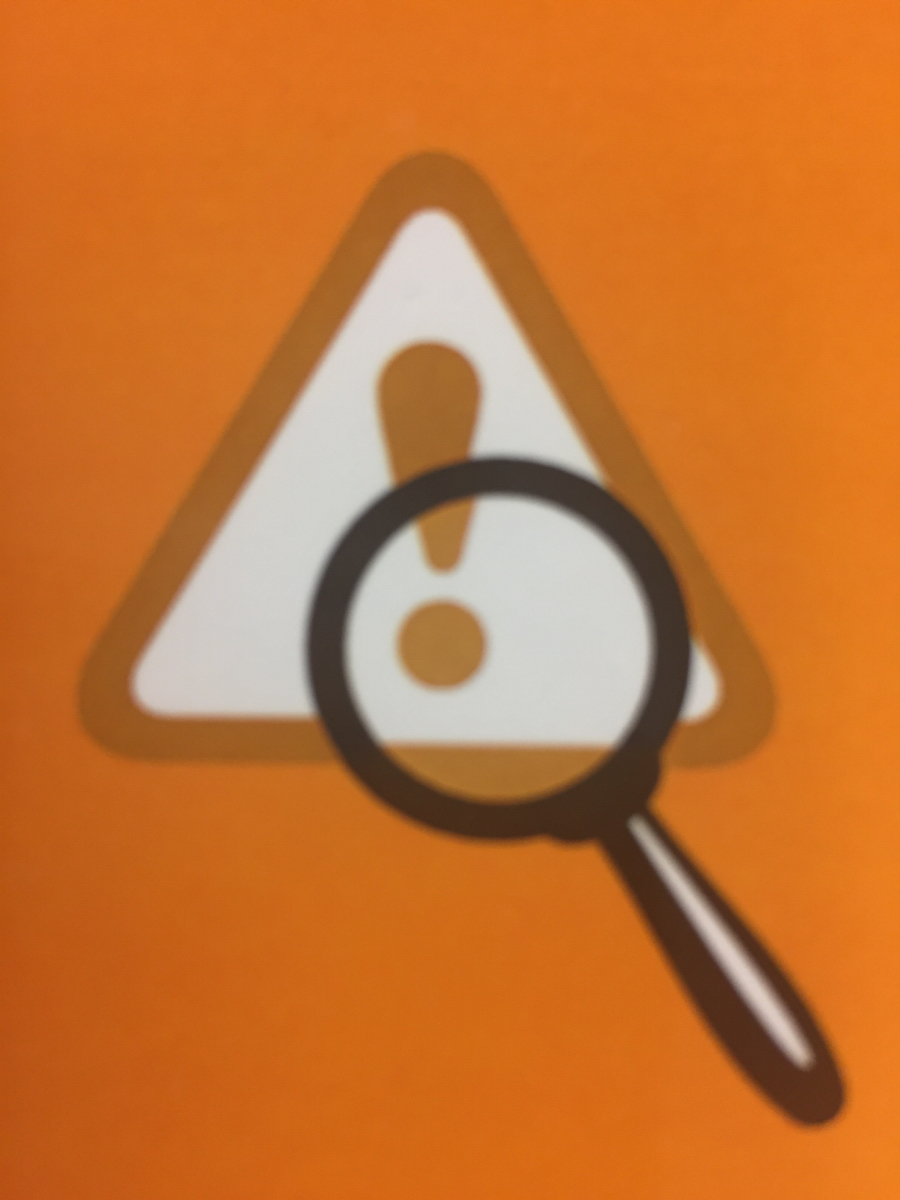Title Page
-
Document No.
-
Weekly log Week Commencing
-
OFFICIAL SENSITIVE
-
Conducted on
-
Prepared by
-
Location
Log
-
Date and time that this Log is started
New entry
-
Entry
- Log Entry
- Log Reviewed by Post Holder
- General Notes
- Decision
- address
- sketch
- photo
- weather
- METHANE
- Conversation
- Personnel
- Briefing
- Local Authority Assets Required
- Formal Meeting
- Local SitRep
- Wide SituationReport
- ETHANE
- Date Change
Review Signature
-
The above entries are confirmed as correct
-
PDF Copy of this Log is to be exported to epo@crawley.gov.uk
LOG
-
-
Information/Message to post holder
-
From
-
Their Contact Details
-
Action by Post Holder
-
Add drawing
-
Add media
-
Action taken at
-
Action Confirmed
CRAWLEY BOROUGH COUNCIL SITUATION REPORT
-
Select date
-
Sit Rep Number
-
Author
-
RAG Status
-
Situation Overview
-
Summary of Response
-
Look Forward
-
Resourcing
-
Add media
TACTICAL COORDINATING GROUP (TCG) SITUATION REPORT
-
Select date
-
Sit Rep Number
-
TCG Chair
-
Author
-
First Report or Guidance needed?
-
-
ANNEX ONE: GUIDANCE NOTES FOR COMPLETING THE SITREP TEMPLATE
Purpose, audience and completion of the SITREP
• The primary audience for the SITREP is the SCG itself.
• Additional audiences will include DCLG Emergency Room, COBR, neighbouring or otherwise affected SCGs and other stakeholders requiring strategic situational awareness.
• The SITREP will usually be drafted in advance of an SCG meeting, then completed and disseminated up/down/sideways as required following the meeting, with agreed actions.
• The SCG and its support staff should determine who completes the SITREP. The GLO/GLT will have a role in synthesising strategic information from the completed SITREP for onward transmission to COBR.
Logic of the template
• The template is a starting point for situational reporting at the strategic level
• The template can be adapted if necessary to fit the specifics of a situation
• Adaptation should not however be done to reflect personal preferences
Protocols for updating
• Material that is new or revised since the previous SITREP should be in red text
• The date/time/source of material should be prominent and clear
RAG status
• The RAG status is an honest and defensible appraisal of three dimensions of the emergency: a) the situation, b) the response to it and c) foreseeable developments.
• Because three dimensions are being combined into a single indicator, and in the absence of a prescribed method of doing so, the RAG status will reflect the collective judgement of the SCG.
• There is no merit in ‘talking up’ or taking an unrealistically optimistic view of where things stand and how they are projected to develop.
• Reading the relevant entry should adequately explain the RAG status given.
• Indicators of the three levels are defined as follows: -
Reporting provenance and quality
• The source/time and assessed quality of information should be clearly and prominently reported.
• Where critical uncertainties (i.e. factors that are unknown, but which have the potential to strategically alter the situation if they become known) exist they should be clearly identified and associated risks set out.
Defining concepts and terms for common understanding
• Where common understanding of a concept or term is necessary for shared situational awareness it should be clearly explained.
• Common understanding of terms cannot be assumed – terms should be defined
• Where agreed definitions exist these should normally be adopted and explained (e.g. there is a definition of ‘flood’ in the Water Flood and Water Management Act 2010).
• Acronyms and abbreviations should be minimised, and always explained at their first use in every issue of the SITREP
Reporting provenance and quality
• The source/time and assessed quality of information should be clearly and prominently reported.
• Where critical uncertainties (i.e. factors that are unknown, but which have the potential to strategically alter the situation if they become known) exist they should be clearly identified and associated risks set out.
Defining concepts and terms for common understanding
• Where common understanding of a concept or term is necessary for shared situational awareness it should be clearly explained.
• Common understanding of terms cannot be assumed – terms should be defined
• Where agreed definitions exist these should normally be adopted and explained (e.g. there is a definition of ‘flood’ in the Water Flood and Water Management Act 2010).
• Acronyms and abbreviations should be minimised, and always explained at their first use in every issue of the SITREP
Examples of content for each of the template sections / cells, including numbers involved, nature and severity of impacts and details as required (NOTE that this is an indicative list, not a comprehensive checklist to report against):
• Key locations (including grid reference or postcode)
• Relevant timings (e.g. timescale to mobilise assets or shut down a facility)
• Impact on health and humanitarian assistance
o Casualties / fatalities / missing persons
o Public Health / healthcare / welfare
o Mortuary capacity and operations
o Humanitarian assistance - Rest Centre and other facilities occupancy
o Primary and Secondary healthcare
o Social care
• Impact on essential services
o Telecommunications
o Electricity
o Gas
o Fuel supply
o Water supply
o Sanitation
o Sewage
o Waste management
o Burials/cremations
o Transport, aviation, maritime, rail, road, bus
o Postal services
o Status of reserves or alternative supplies
• Impact on communities:
o Impact on private dwellings
o Impact on public premises / assets
o Homecare
o Vulnerable people/groups
o Evacuation
o Housing and temporary accommodation
o Impact on community transport
o Impact on education
o Community response: nature and extent
o Engagement by the voluntary sector
• Economic impact:
o Businesses directly and/or indirectly affected (numbers or range if estimate)
o Supply chain consequences
o Impact on workforce
o Impact on tourism
o Rural economy (farms, food production sector, etc.)
• Environmental impact
o Water contamination
o Land contamination
o Air pollution
o Waste management issues which may be associated with the response
o Impact on agriculture
o Food availability/supplies
o Animal welfare
• Criminal Justice Issues
o Prisons
o Public order/crime
o Courts
o Protection of property
o Community safety / community cohesion Issues
• Issues relating to response and capability
o Specified, implied, essential, and potential tasks
o Weather: forecast and associated risks
o Current status of resources / capabilities (dispositions and availability)
o Mutual aid / military support
o Key considerations and assumptions
o Constraints on the operation (e.g. time, resources, sustainment, distance, demand and duration)
o Recommended timelines
o Contingency planning
o Capacity of local tier to respond
o Finance
• Emerging recovery issues
o Infrastructure and essential services repair and/or reconnection
o Financial assistance (e.g. business rate or council tax relief)
o Insurance issues
o Any bureaucracy or “red tape” challenges
o Bellwin Scheme
o Future resilience investment
o Lessons (to be) identified -
Situation Overview
-
Summary of the Response
-
Look Forward
-
Resource Issues
-
Strategy
-
Working Strategy
-
Overarching Aim
-
Objectives
-
Media Strategy
-
Emergency Services RAG Status
-
Police
-
Fire
-
Ambulance
-
Other
-
Local Authority(ies)
-
State the name of the Authority in the Notes Column
-
For the RAG Status of the Crawley Council see RAG Status number
-
Health
-
Public Health England
-
Local Public Health
-
NHS England
-
Environment Agency
-
Forecast
-
Likely impacts and risks arising
-
Current situation
-
Met Office
-
Forecast
-
Likely impacts and risks arising
-
Current situation
-
Transport
-
Highways England
-
Network Rail
-
Highways Authority (see LA)
-
Train Operating Company
-
Other
-
Utilities
-
Gas
-
Water
-
Telecoms
-
Other
-
Electricity
-
Voluntary Sector
-
Enter the name of the organisation in the notes column
-
Military
-
Overview
By Unit
-
Enter the name of the unit or by capability area in the notes column
-
Summary of other involved groups
-
STAC
-
Humanitarian Assistance
-
Recovery Group
-
Other responders
-
Enter the Organisation name in the notes column
-
Other Issues not covered Elsewhere
-
Date and Time of Next expected update
General Notes
-
Select date
-
Notes
-
Notes
-
Notes
Meeting
-
Date and time of meeting
-
Organisation calling the meeting
- Other
- Met Office
- Police
- Fire
- Ambulance
- Local Authority - Upper Tier
- Local Authority - Lower Tier
- Coastguard
- Environment Agency
- Primary care
- Acute Care
- Military
- Voluntary Aid
- Harbout/Airport
- HSE
- Phone Provider
- Gas Distribution
- Electricity
- Water
- Highways England
- Railways
-
Method of meeting
- SMS
- Radio
- Face to Face Meeting
- Telephone
- Video Phone
- Paged Message
-
Chair
-
Contact Details
Reports
-
Organisation report notes for
- Other
- Met Office
- Police
- Fire
- Ambulance
- Local Authority - Upper Tier
- Local Authority - Lower Tier
- Coastguard
- Environment Agency
- Primary care
- Acute Care
- Military
- Voluntary Aid
- Harbout/Airport
- HSE
- Phone Provider
- Gas Distribution
- Electricity
- Water
- Highways England
- Railways
-
Name
-
Notes
Review Signature
-
The above entries are confirmed as correct
-
PDF Copy of this Log is to be exported to epo@crawley.gov.uk
End of day.
-
Start of new days log
-
- Monday
- Tuesday
- Wednesday
- Thursday
- Friday
- Saturday
- Sunday
Location
-
Select date
-
Add location
Sketch
-
Sketch of Location
-
Select date
-
Sketch of;...
-
Add drawing
Photo
-
Select date
-
Photograph of;...
-
Image
ETHANE Report
-
Select date
-
Exact Location
-
Exact Location
-
Exact Location - Ensure GPS tagging is turned on
-
Exact Location
-
Type of Incident
-
The nature of the incident, including how many vehicles, buildings and so on are involved
- Road Traffic
- Weather
- Flood
- Fire
- Building
- Disease
- Wind
- Railways
- Aircraft
- Explosion
- Evacuation
- Terrorism
- Criminal
- Trapped
- Chemical
- Smoke
- Gas
- Other
-
Description
-
Description
-
Hazards - both present and potential
-
- H1. Domestic Gas Escape
- H2. Oxyacetelyne / LPG
- H3. Bulk Fuel
- H4. Chemical
- H5. Biological
- H6. Radiation
- H7. Explosives or Bombs
- H8. Water
- H9. Electricity
- H10 Other
-
Access
-
Annotated Screen print from Google Eath
-
Route Diagram
-
Numbers of Casualties
-
How Many
-
How Many
-
How Many
-
Emergency Services - Category 1
-
Police
-
Fire
-
Ambulance
-
Local Authority - Upper Tier
-
Local Authority - District / Borough
-
MCA
-
NHS
-
Category 2 responders
-
Highways England
-
Strategic Health Authority
-
Gas Distributers
-
Water & Sewerage
-
Electricity Providers
-
Communications Providers
-
Rail Operators / Network Rail
-
HSE
-
Port Operator
Major Emergency Declared METHANE
-
Select date
-
Major Emergency; Has a Major Emergency been Declared? If so by whom?
-
Exact Location
-
Exact Location
-
Exact Location - Ensure GPS tagging is turned on
-
Exact Location
-
Type of Incident
-
The nature of the incident, including how many vehicles, buildings and so on are involved
- Road Traffic
- Weather
- Flood
- Fire
- Building
- Disease
- Wind
- Railways
- Aircraft
- Explosion
- Evacuation
- Terrorism
- Criminal
- Trapped
- Chemical
- Smoke
- Gas
- Other
-
Description
-
Description
-
Hazards - both present and potential
-
- H1. Domestic Gas Escape
- H2. Oxyacetelyne / LPG
- H3. Bulk Fuel
- H4. Chemical
- H5. Biological
- H6. Radiation
- H7. Explosives or Bombs
- H8. Water
- H9. Electricity
- H10 Other
-
Access
-
Annotated Screen print from Google Eath
-
Route Diagram
-
Numbers of Casualties
-
How Many
-
How Many
-
How Many
-
Emergency Services - Category 1
-
Police
-
Fire
-
Ambulance
-
Local Authority - Upper Tier
-
Local Authority - District / Borough
-
MCA
-
NHS
-
Category 2 responders
-
Highways England
-
Strategic Health Authority
-
Gas Distributers
-
Water & Sewerage
-
Electricity Providers
-
Communications Providers
-
Rail Operators / Network Rail
-
HSE
-
Port Operator
Decision
-
Select date
-
Decision Made
-
Reasoning Behind the Decision
-
Initials
Conversation notes
-
Select date
-
Media Used
- SMS
- Radio
- Face to Face Meeting
- Telephone
- Video Phone
- Paged Message
-
When Transmitted
-
Message was read
-
Content
-
Copy of email for evidence
-
Response sent?
-
When the response was sent
-
Content of response
-
Conversation with....
-
Content Notes
Personnel
-
Select date
-
Agency
- Other
- Met Office
- Police
- Fire
- Ambulance
- Local Authority - Upper Tier
- Local Authority - Lower Tier
- Coastguard
- Environment Agency
- Primary care
- Acute Care
- Military
- Voluntary Aid
- Harbout/Airport
- HSE
- Phone Provider
- Gas Distribution
- Electricity
- Water
- Highways England
- Railways
-
Name - Include Particular Company or Division if relevant
-
Contact Details
Briefing
-
Select date
-
Location of next Briefing
-
When the Briefing is due. (be there 5 minutes early)
-
Briefing Agency
- Other
- Met Office
- Police
- Fire
- Ambulance
- Local Authority - Upper Tier
- Local Authority - Lower Tier
- Coastguard
- Environment Agency
- Primary care
- Acute Care
- Military
- Voluntary Aid
- Harbout/Airport
- HSE
- Phone Provider
- Gas Distribution
- Electricity
- Water
- Highways England
- Railways
-
Briefing Notes
Local Authority Assistance required.
-
Select date
-
Assets Requested
- Dangerous Structure - Building Control
- Site Clearance - Waste Management
- Evacuee Transport
- Workforce Transport
- Rest Centre
- Humanitarian Assistance Centre
- Pollution Issues
- Identifying Vulnerable
- Bio Waste Removal
- Other
Essential Contacts List
- Contact
-
Organization
- Other
- Met Office
- Police
- Fire
- Ambulance
- Local Authority - Upper Tier
- Local Authority - Lower Tier
- Coastguard
- Environment Agency
- Primary care
- Acute Care
- Military
- Voluntary Aid
- Harbout/Airport
- HSE
- Phone Provider
- Gas Distribution
- Electricity
- Water
- Highways England
- Railways
-
Name
-
Contact type
- Landline
- Mobile
- Pager
- website
- postal address
- other
-
Landline
-
Mobile
-
Pager
-
Email
-
Website
-
Address
-
Other
End of Log
-
Add signature






